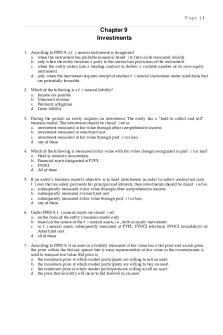Contour Plan - Report (9/10) PDF

| Title | Contour Plan - Report (9/10) |
|---|---|
| Author | Emily Liu |
| Course | Surveying |
| Institution | University of Technology Sydney |
| Pages | 1 |
| File Size | 36.9 KB |
| File Type | |
| Total Downloads | 80 |
| Total Views | 144 |
Summary
Report (9/10)...
Description
UNIVERSITY OF TECHNOLOGY, SYDNEY SURVEYING 48320 STADIA AND CONTOUR PLAN EXERCISE – COMMENTS ON RESULTS The field work was completed on the 29th of September 2017 on a Friday afternoon. The practical session was started at 1:30pm and finished around 4:30pm. The weather conditions that this exercise was conducted in was very hot and sunny. A theodolite and staf was used to measure distances and reduced levels to create a contour plan of the Mary-Ann Street park. Due to being a very hot day, viewing through the lens heated air was seen rising which slightly obscured reading the levels for certain points. This is an error that needs to be factored in to account for the degree of accuracy of the contour plan. Overall, the results from the field work was done to satisfactory level with no obvious mistakes. All on-site data was recorded on the STADIA booking sheet and a sketch of the site. The most important point which was the first staf reading was the Benchmark situated in the centre of the north-western footpath. The next most important points to record were the edges of the boundary to be surveyed which is the perimeter of the park. Each corner and multiple points along the edges were recorded. Next were a few spot heights in the centre of the park to give a more precise indication of the nature of the park surface level. After those main points were recorded, tree line points were taken and a drainage pit location. The last field work readings taken were the widths of the internal foot paths and garden beds. There were 15 other groups undertaking the exercise. Our theodolite was set up at the northern corner of the park. As all the students were also set up along the Bulwara Road edge of the park this meant that when taking measurements for the SE corner there were a lot of people in the way. To combat this, we chose to extend our staf to look over the top of them and hence increasing our level of uncertainty with measurements. This is because, as the staf is extended it is harder to keep perfectly plum. As the distance along Bulwara Road was relatively short it also meant that any error in the staf reading would be accentuated when converting to a horizontal distance because of the greater vertical angle. Ideally, we would aim to make readings as accurate as possible and in future perhaps change set up positions to get a clear line of sight. After entering the data into the STADIA reductions spreadsheet there was no obvious mistake. A few readings had diferences between the top, middle and bottom hair but only within 20mm which was corrected. Besides this, there were no blunders or total mistakes made even though our experience is very limited. Total mistakes are often easy to spot but usually cannot be corrected. A re-run would be the best solution. Systematic errors are a potential and could have been the case with the small hair diferences but this is unlikely in this situation. We did have an issue with one of the precision knobs that wouldn’t tighten when locking it to a vertical. We were just more careful to not touch the theodolite once set to a mark. Random errors are often due to human error and inability to be perfect. Laws of probability can allow for these errors. Once all points were plotted on the plan at a scale of 1:250, the contours were plotted via interpolating the 1m intervals. In conclusion, the exercise was undertaken with consistent and accurate results....
Similar Free PDFs

Contour Plan - Report (9/10)
- 1 Pages

910-quiz
- 11 Pages

Evaluacion NTC 4983 - 910
- 2 Pages

06 3-910 exercice de pratique TI
- 4 Pages

ENT300 Business PLAN Report
- 101 Pages

Business plan ent530 - Report
- 84 Pages

Nitori Makreting PLAN Report
- 28 Pages

MARKETING PLAN REPORT (MyLocation)
- 30 Pages

Dominos Pizza Marketing Plan Report
- 20 Pages

MPU Report Business PLAN -converted
- 47 Pages

Report pgt201e RPH lesson Plan
- 7 Pages

MKT 243 Marketing Plan Report
- 23 Pages

Chapter 3 - Business Plan Report
- 3 Pages

(ENT300)Business Plan Report Latest
- 55 Pages
Popular Institutions
- Tinajero National High School - Annex
- Politeknik Caltex Riau
- Yokohama City University
- SGT University
- University of Al-Qadisiyah
- Divine Word College of Vigan
- Techniek College Rotterdam
- Universidade de Santiago
- Universiti Teknologi MARA Cawangan Johor Kampus Pasir Gudang
- Poltekkes Kemenkes Yogyakarta
- Baguio City National High School
- Colegio san marcos
- preparatoria uno
- Centro de Bachillerato Tecnológico Industrial y de Servicios No. 107
- Dalian Maritime University
- Quang Trung Secondary School
- Colegio Tecnológico en Informática
- Corporación Regional de Educación Superior
- Grupo CEDVA
- Dar Al Uloom University
- Centro de Estudios Preuniversitarios de la Universidad Nacional de Ingeniería
- 上智大学
- Aakash International School, Nuna Majara
- San Felipe Neri Catholic School
- Kang Chiao International School - New Taipei City
- Misamis Occidental National High School
- Institución Educativa Escuela Normal Juan Ladrilleros
- Kolehiyo ng Pantukan
- Batanes State College
- Instituto Continental
- Sekolah Menengah Kejuruan Kesehatan Kaltara (Tarakan)
- Colegio de La Inmaculada Concepcion - Cebu

